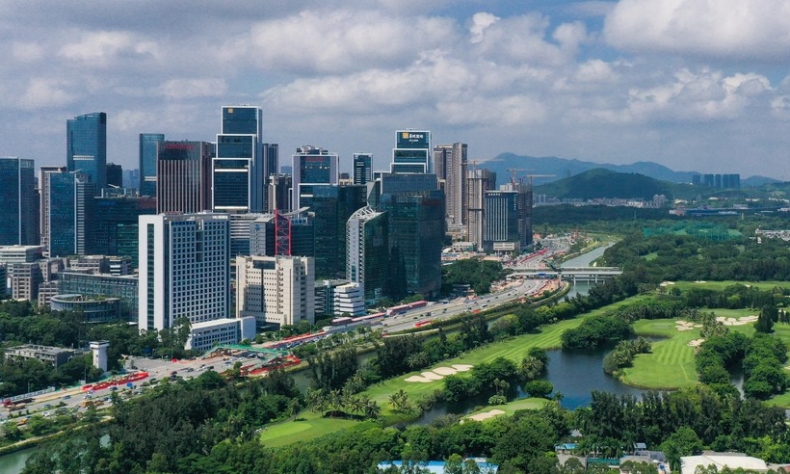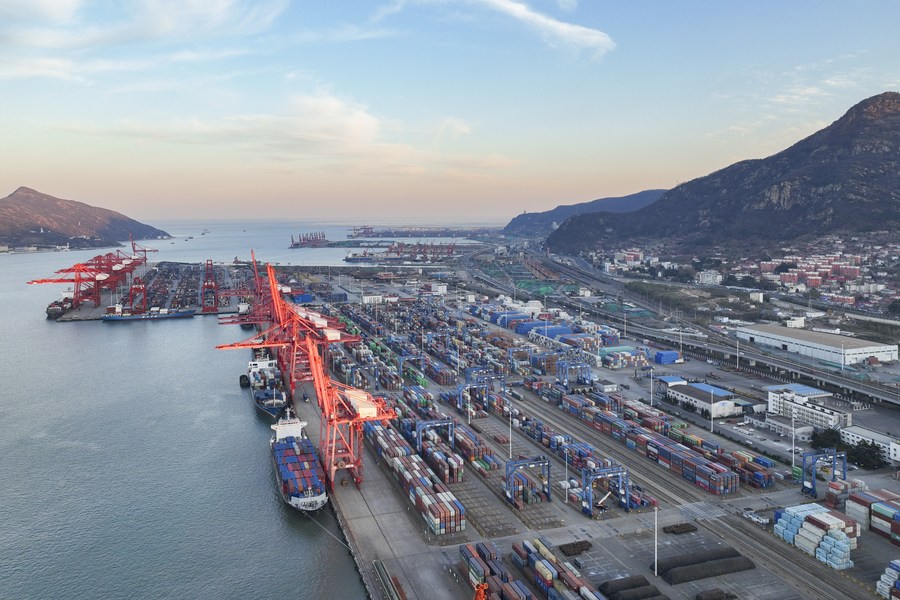The Long-term Positive Trend of China’s Economy Will Remain Unchanged

China’s pattern is, if we can bake a bigger prosperity pie, everyone in the community with a shared future can get a bigger slice.
Editor’s Note: In an interview with Beijing Review reporter Tao Xing, Zhang Yansheng, principal researcher with the China Center for International Economic Exchanges, shared his assessments of China’s macroeconomic landscape. Edited excerpts of his views follow:
Priorities and forecasts
Last year, China’s economic operation achieved relatively high growth with GDP reaching 114 trillion yuan ($17.9 trillion), up 8.1 percent year on year. The progress was largely led by internal momentum, rather than supported by economic stimulus, and this exactly marks the difference between China and other major world economies. For example, U.S. growth was driven by massive fiscal stimulus; China did not apply any such expansionary policy, but opted for a relatively tightening one instead.
Targeted GDP growth this year is around 5.5 percent, confidently demonstrating the long-term positive trend of China’s economy will remain unchanged.
Due to sporadic COVID-19 cases in some regions and other downward pressures including floods and energy shortages, China’s economic growth speed declined to a certain extent in the third and fourth quarters of last year. In addition, there were the misinterpretations of several state policies, for example, likening common prosperity to “robbing the rich to pay the poor.” The combination of these factors left some international and domestic institutions with rather bleak economic forecast.
The Central Economic Work Conference in December 2021 said economic work in 2022 should prioritize stability while pursuing progress, underlining the importance to safeguard macroeconomic stability, keep major economic indicators within an appropriate range and maintain social stability.
The meeting addressed the misunderstanding of topics affecting public confidence in economic growth, stating that the objective of common prosperity is to “bake a bigger pie” of social wealth by developing the economy, so everyone in the country can get a bigger slice. It also noted that the positive role of capital must be given full play to amid tightened supervision, and highlighted the need to focus on people’s wellbeing, ramp up support for technological innovation and promote more balanced and better coordinated regional development.
The deficit-to-GDP ratio this year is set around 2.8 percent; lower than last year’s. This shows that China will still feature stability at the top of its policy agenda and aims to keep the macro leverage ratio generally stable. It will refrain from a deluge of stimulus, implementing precise policies instead.
Currently, several fields and sectors hit hard by the epidemic are experiencing a recovery slower than that of the overall market, often in terms of consumer and investment demand. Challenges are significantly severe for transportation and logistics firms, catering and accommodation companies, as well as micro, small and medium-sized enterprises. In response, the government has rolled out targeted policies to help them overcome their problems.
In addition, capital flow into China continues and, on the other hand, yuan-denominated assets have become increasingly favored as a risk hedge. This illustrates that global investors are optimistic about the Chinese economy in 2022 and its long-term development prospects.

Forging a new path
Marked by the eradication of absolute poverty in late 2020, China has entered a new stage of development.
Over 40-plus years of reform and opening up, the main focus has been on the participation in the international supply and value chains and economic performance improvement through developing a market economy, boosting export-oriented sectors and speeding up industrial modernization. In the newest stage of development, China homes in on three main aspects: technological development, basic research in particular, law-based governance and common prosperity.
Enterprises should focus on innovation while not using their capital to abuse market dominance. In their quest for profits, they shall meanwhile fulfill their corporate responsibilities, serve the country’s development and help the people pursue a better life.
The dual circulation development strategy takes domestic circulation as the main body, with domestic and international circulations reinforcing each other. We should continue to expand domestic demand and ensure consumption remains the main driving force of economic growth.
By 2035, China’s consumer market is expected to achieve the total volume of the U.S. and the EU combined. More efforts are needed to increase per-capita disposable income, improve the proportion of household consumption in GDP and double the size of the middle-income group. Families with an annual disposable income of 100,000-500,000 yuan ($15,667-78,200) are considered middle-income earners in China.
High-standard opening up is another means to boost high-quality development.
We should open the market wider, with an emphasis on improving trade and investment facilitation and easing market access to service sectors. The foreign investment management model of pre-establishment national treatment plus a negative list must be systematically implemented.
China has ratified the Regional Comprehensive Economic Partnership, the world’s largest free trade agreement consisting of 15 Asia-Pacific economies which entered into force this January, with over 90 percent of merchandise trade among members that have approved the agreement eventually being subject to zero tariffs. It has also applied to join the Comprehensive and Progressive Agreement for the Trans-Pacific Partnership (CPTPP), an 11-member trade agreement, which will reduce import duties to zero on 99 percent of tariff lines when fully implemented. These moves demonstrate its commitment to a greater opening up.
Deeper integration with the world economy is also essential for China to align with international practices. For example, membership in the CPTPP, widely considered to have the highest standards for trade rules and market access, is expected to promote China’s economic institutional openness to a higher level and push forward the improvement of policies regarding state-owned enterprise reform, industrial development, intellectual property protection and the digital economy.
Then, China should have more innovation-related cooperation. We need to learn from foreign achievements to advance our research in fields like science, technology, engineering and mathematics.

Everybody wins
The cliché of “decoupling” from China is only trumpeted by a minority; the vast majority will opt to close ranks.
On the one hand, U.S. containment against China has been escalating in finance, trade, technology and other fields. On the other hand, international investors have constantly increased their holding of yuan-denominated assets. For example, JPMorgan added Chinese government bonds to its benchmark emerging-market indexes from February 2020 onward.
Furthermore, China will always attach great importance to imports. At present, the country has become the largest trading partner of over 120 countries and regions and is the developing country attracting the most foreign investment in the world. In the future, China is expected to become a trade deficit country with more imports than exports. This means China could provide the world with more orders, opportunities—and motivation. Given this, will foreign businesses be willing to decouple from China’s consumption market?
Chinese culture is unlike that of the West. The country does not approve of the “winner takes all” law of the jungle or zero-sum games; China’s pattern is, once again, if we can bake a bigger prosperity pie, everyone in the community with a shared future can get a bigger slice.
China will continue to develop its mechanism of collaborating and sharing with the world.
 Facebook
Facebook
 Twitter
Twitter
 Linkedin
Linkedin
 Google +
Google +










